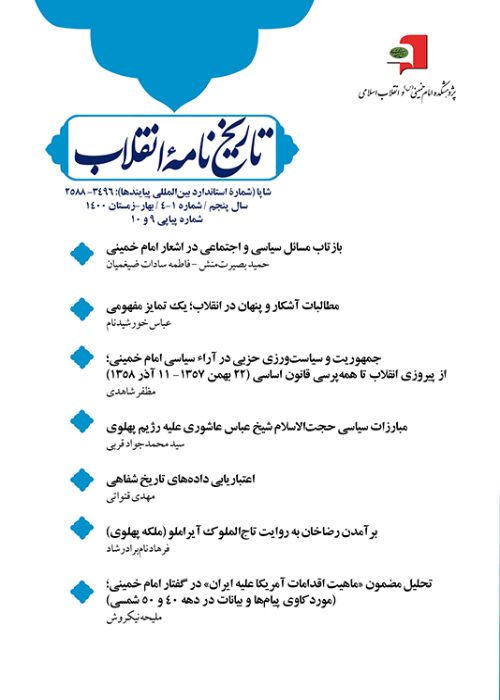Pathology of Analysis Methods in the Historiography of the Islamic Revolution
Author(s):
Article Type:
Research/Original Article (بدون رتبه معتبر)
Abstract:
The methods of analyzing the history of the Islamic Revolution, especially by Western, Arab, counter-revolutionary and dissident writers, have been influenced by their mentality and their perception of the phenomenon of the Islamic Revolution as well as its developments and periods. Their reliance on their own subjective and perceptual understanding of the events for the historiography of the Islamic Revolution suggests that their stereotypes and mental frameworks, or their stigmas and their mental patterns, have undermined the data analysis and consequently disturbed their understanding of the realities and of objective changes of Iranian society and government after the Islamic Revolution. The pathological study of the analytical work of pessimist historians towards Islamic Revolution from epistemological and methodological angle reveals some deficiencies as follows: reductionism ( providing explanation to the reality in terms of smaller entities and through absolutist and dualistic “black and white” approach to political phenomena), the self-confirmation bias ( also called confirmatory bias or myside bias, in the sense of tendency to search for information in a way that confirms their own preexisting beliefs or mental assumptions rather than searching for historical realities), anachronism (in the sense of attributing the new analytical ideas to the historiography of the Islamic revolution beyond the actual time of the revolution), anatopism (in the sense of analyzing the Islamic Revolution out of its proper place, neglecting the historical and cultural particularities of Iranian society), contex to my (in the sense of quoting Islamic Revolution leaders out of context in order to depict false attribution through selective analysis of the text or of cut-off phrases by removing a passage from its surrounding phrases, in order to distort its intended meaning for critical specific purposes) and presentism (in the sense of historiography and interpretation of Islamic Revolution events in terms of modern values and concepts as well as evaluation of some periods of the Islamic revolution by critical adherence to present-day attitudes and today’s criteria of domestic and international society ). At the end of the article, the author explains and proposes a realistic analytical-synthetic approach for the historiography of the Islamic Revolution based on the interaction of the context, structure, process and agent and the horizontal-vertical synthesis.
Keywords:
Language:
Persian
Published:
Journal of Tarikhname-Ye Enghelab, Volume:2 Issue: 1, 2018
Pages:
9 to 34
magiran.com/p1901657
دانلود و مطالعه متن این مقاله با یکی از روشهای زیر امکان پذیر است:
اشتراک شخصی
با عضویت و پرداخت آنلاین حق اشتراک یکساله به مبلغ 1,390,000ريال میتوانید 70 عنوان مطلب دانلود کنید!
اشتراک سازمانی
به کتابخانه دانشگاه یا محل کار خود پیشنهاد کنید تا اشتراک سازمانی این پایگاه را برای دسترسی نامحدود همه کاربران به متن مطالب تهیه نمایند!
توجه!
- حق عضویت دریافتی صرف حمایت از نشریات عضو و نگهداری، تکمیل و توسعه مگیران میشود.
- پرداخت حق اشتراک و دانلود مقالات اجازه بازنشر آن در سایر رسانههای چاپی و دیجیتال را به کاربر نمیدهد.
In order to view content subscription is required
Personal subscription
Subscribe magiran.com for 70 € euros via PayPal and download 70 articles during a year.
Organization subscription
Please contact us to subscribe your university or library for unlimited access!


